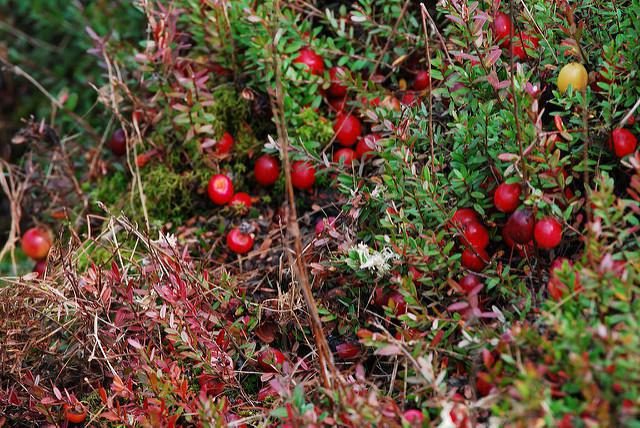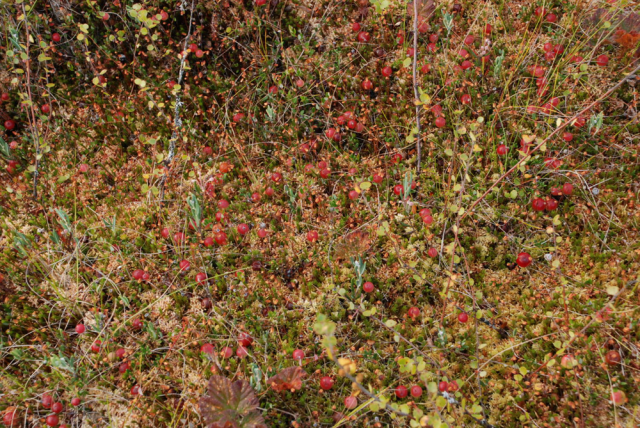Content
Cranberries are a wild, healthy berry that grows in northern latitudes. Contains a huge amount of nutrients and useful substances that help to strengthen the immune system and fight all kinds of infections. How and where cranberries grow should be known to everyone who goes for this storehouse of vitamins.
General information and varieties
All cranberries belong to the Heather family and are related to bilberries, blueberries and lingonberries. In total, there are 4 varieties of cranberries that grow in the wild:
- Common cranberry. The shrub is classified as evergreen and grows in the northern and temperate latitudes of the Eurasian continent. Creeping plant, shoots up to 80 cm long. The leaves are ovoid up to 100 mm long. Blooms in May-June. It ripens in September. The diameter of the berries is 16 mm.
- Small-fruited. The shoots of this shrub spread 30 cm. The plant is listed in the Red Book of many regions. Fruits up to 8 mm in diameter.
- Large-fruited. Distributed mainly in Canada and the United States. The fruit of this berry reaches 25 mm in diameter. On its basis, large varieties of cultivated cranberries are developed.
Now the berries are harvested not only by hand, but also with a special harvester. This allows you to harvest nutritious and healthy berries on an industrial scale.
There is also a hybrid bred in the United States for cultivation. For a long time, mankind could not tame wild berries, since cranberries are very capricious to the environmental conditions in their places of growth and require increased soil fertility. The homemade cranberry variety appeared only at the end of the 19th century. It grows easier in comparison with the wild one under human supervision and has fewer requirements for soil and moisture.
At the same time, the wild berry tries to grow in places located far from human habitats. Therefore, berry lovers can walk more than one kilometer before stumbling upon thickets of a useful product.
Correctly harvested and harvested cranberries serve as an antipyretic, anti-inflammatory, and immunity-strengthening agent. It can be used to treat colds, including in pregnant women and children. The berries also have limitations, in particular, it cannot be eaten in large quantities by people with stomach ulcers and other problems of the mucous membrane of the gastrointestinal tract.
How cranberries grow
Cranberry is a marsh berry and grows in peat and sphagnum bogs. In Russia, the berry grows exclusively in the Northern Hemisphere, as well as in damp coniferous forests and humid lowlands. They also attract berries and peat deposits. In our country, it is impossible to find cranberries only in the southern regions, with a minimum number of winter months and dry soil. In Russia, it is found in Kamchatka, Karelia, Sakhalin and Siberia. Everywhere in those regions that belong to the tundra and forest-tundra, as well as in the taiga moist, coniferous forests, where swamps and wet lowlands are often found.
It is noteworthy that in different territories the berry has its own names. For example, in the Pskov region of Russia, it is called a vesnyanka, and the Ukrainians call it a zhuravinnik. In Belarus, this berry is called zhuravina.
Comparison of cranberries with a crane is no coincidence - the berry is located on a long stem, which resembles a thin and long neck of a crane.
It is interesting that cranberries most often grow in those places where people have not spoiled the environment and have not developed a vigorous economic activity.This is a kind of indicator that the nature around is clean, and much has been preserved in its original form. The main conditions for the growth of this berry are sufficient moisture and fertile soil.
What does cranberry look like?
The cranberry is a small evergreen shrub. The shoots of the shrub are thin and spread widely around. In this case, they can take root with special adventitious roots of a very small size.
The leaves of the shrub are small, with short cuttings and ovoid. From above, the leaves are slightly pointed, and their edges are intact, slightly bent down.
On the upper side, the leaves are dark green in color and have a shiny surface. Below, the color is grayish.
The flowers are drooping, small in size, located on long pedicels. The flowers are white in color, often with a pink tint. Cranberries bloom in late spring and early summer. Only 3 months after the start of flowering can you harvest. The uniqueness of this berry is that it can be harvested both unripe and already winterized in the spring, after the snow melts. True, in the spring, cranberries already contain much less vitamins and nutrients.
The fruits are basically spherical, sometimes small ovoid berries. When the fruits are formed, they are white and then turn red. The color is bright, with a gloss, and the dimensions reach 13 mm in diameter.
In order to increase the yield, cranberries are grown on special plantations on an industrial scale. There, the harvest is 20-30 times more.
When cranberries are harvested
The berry has several harvest dates. It all depends on the preferences and taste of consumers:
- Summer. The berry at this moment is not yet fully ripe. The sides of the berry are reddish or pink. Such fruits can ripen on the windowsill, but they have an order of magnitude less nutrients and have a bitter taste. Such berries are usually harvested for long-term transportation.
- Autumn. The cranberry at this moment is brown in color and has the highest degree of ripeness. The high content of pectin in these berries allows them to be preserved with high quality and stored for a long time in the form of blanks for the winter. Autumn cranberries are also important for winemakers, as special microorganisms form on their skins, which contribute to the fermentation process.
- Spring. The overwintered berry accumulates a large amount of sugar, and therefore the taste of spring cranberries is not so sour. But there is practically no vitamin C in this berry. Moreover, it is poorly transported and not stored.
When cranberries ripen in Russia
Ripening of useful raw materials occurs depending on the region. The first harvest ripens in early September, and in the central regions of Russia - by mid-September. If at this time to collect cranberries and sort out, then whole berries can be easily poured with cold water and left in a cool place for storage until next year.
The second term for collecting wild raw materials is November, with the onset of frost. And until the moment of the first snow. In some regions, cranberries are prized after frost, as they become sweeter.
The third collection period is early spring, immediately after the snow melts. But during this period, it should be collected very carefully, since it is easily wrinkled and poorly transported. And you need to know the places, where cranberries can be found, and where they have not yet been harvested.
How cranberries grow in a swamp
Everyone knows that the wild northern berry grows in a swamp. Therefore, you need to collect cranberries with great care. Cranberry thickets creep like a carpet across the swamp, only slightly rising above the ground.
It is optimal when collecting to use a special comb, wooden or metal. This makes the berry easier to find, since it hides under the leaves and is not always visible to the naked eye.
Conclusion
How and where the cranberry grows is known to all lovers of "quiet hunting". These are northern taiga forests, where swamps and high soil moisture are common. In these places there is always a clearing, where a bush with bright red beads spreads like a carpet. It is important to carefully prepare and be careful when picking berries, as cranberries love swampy places with a lot of bog, where they can get bogged down. But the collection time is very extensive: from the beginning of September until the complete imposition of the snow cover. In some regions, the harvest is also happy to be harvested in the spring. But experts with experience say that the most delicious and healthy berry is after the first frost.












